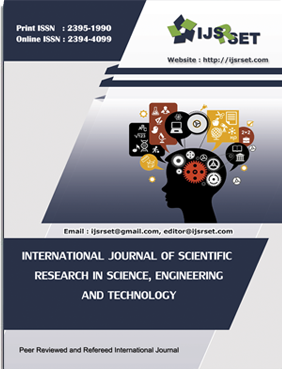The Behavior of High Scanning Electron Voltage in SEM Due to Mirror Effect
DOI:
https://doi.org/10.32628/IJSRSET24114117Keywords:
Electron Trajectory, Electron Mirror Effect, Scanning Electron MicroscopeAbstract
To determine the factors influencing the electron scattering process in a scanning electron microscope caused by the electron mirror, a set of physical and mathematical ideas were used. These equations, which relate the scattering of the input electron with the surface potential energy of the dielectric material under examination using a matched beam ion microscope and scanning electrons, are based on simplified engineering mathematics. After five minutes of charging the insulator to saturation with an acceleration voltage of 30 kV, the accumulated charge was 0.3 nC, from which the surface voltage across the working distance (WD = 15 mm) was determined. The scattering angle (β) was found to be inversely proportional to the incidence angle (θ) in the second stage, when scanning voltages (Vsc=2, 4, and 6 kV) were employed. This was because the angle between the incident and scattered electron (2
📊 Article Downloads
References
Abbood T., “Determination of electron location using mirror effect phenomena in scanning electron microscope”, J. Phys. Ser. vol. 1963, pp. 1-10. (2021). DOI: https://doi.org/10.1088/1742-6596/1963/1/012114
Abbood T., Formal Invedtigation of the Mirror Effect in SEM, PhD. Thesis: College of Education, University of Al-Mustansiriyah, Baghdad, Iraq. (2010).
Al-Obaidi H., Khaleel I., Modelling of electron trajectories inside SEM chamber concerning mirror effect phenomenon, vol. 11, No. 21, pp. 12-19. (2013). DOI: https://doi.org/10.30723/ijp.v11i21.362
Al-Zahy Y., ‘Differential cross section for reflected electrons measured by electron mirror method’, J. of Nanophotonic, V. 9. (2015). DOI: https://doi.org/10.1117/1.JNP.9.093096
Belhaj, M., Jbara, O., Filippov, M., Rau, E., and Andrianov, M., “Analysis of two methods of measurement of surface potential of insulators in SEM: electron spectroscopy and X-ray spectroscopy methods”, Appl. Surf. Sci., vol. 177, pp. 58. (2001a). DOI: https://doi.org/10.1016/S0169-4332(01)00209-4
Hafner, B.,” Scanning Electron Microscopy”, Primer University of Minnesota. (2007).
Milani, M., Abdul-Wahab H., Abbood T., Savoia C., and Tatti F., ‘Rear window: looking at charged particles hitting a charged target in a FIB/SEM’, Microscopy: Science, Technology, Applications and Education. (2010).
Potts, P., A Handbook of Silicate Rock Analysis, Blackie, p. 336. (1987). DOI: https://doi.org/10.1007/978-94-015-3988-3
Vallayer, B., Blaise, G., and Treheux, D., “Space charge measurement in a dielectric material after irradiation with a 30 kV electron beam: Application to single-crystals oxide trapping properties”, Rev. Sci. Instr., vol. 70, No. 7, pp. 3102. (1999). DOI: https://doi.org/10.1063/1.1149887
Downloads
Published
Issue
Section
License
Copyright (c) 2024 International Journal of Scientific Research in Science, Engineering and Technology

This work is licensed under a Creative Commons Attribution 4.0 International License.




